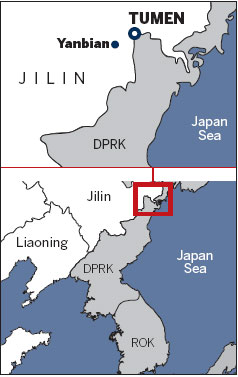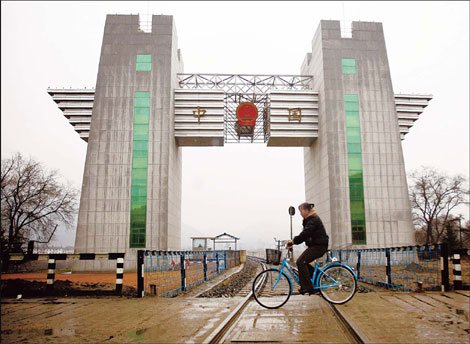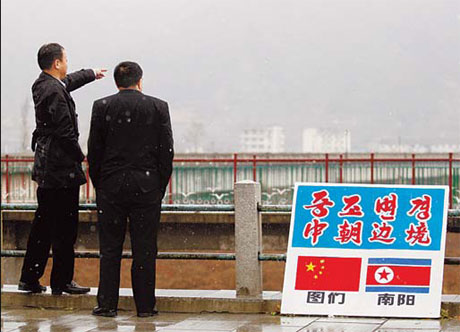Life and Leisure
Silent city
By Cao Li (China Daily)
Updated: 2010-11-19 08:04
 |
Large Medium Small |
|
|
There is hardly any cross-border trade happening at a market established in Tumen in Northeast China, bordering DPRK, and the city is fast acquiring a deserted look. Cao Li reports
A market in the center of Tumen city in Northeast China's Jilin province is eerily quiet. There are no customers here. A winter wind has replaced what should have been the sound of merchants selling their wares, and snow blankets the empty square and two blue temporary cabins. At this empty site lie scattered the hopes for grassroots trade between China and the Democratic People's Republic of Korea (DPRK), which was expected to bring the region up to speed with the prosperity in the rest of the country.
"There are not enough products from North Korea to sell here," says an official from the local commerce bureau who declined to give his name. "I don't know when there will be."
After the market was established in September and officially unveiled on Oct 13 - after the latest visit of DPRK leader Kim Jong-il - it has been open only four times.
It is now as quiet as Namyang, its neighboring Korean city across the Tumen River, which flows through China, DPRK and Russia and into the Japan Sea.
Located next to a bridge between Tumen and Namyang, the market of 10,000 square meters is divided into trading and custom inspection sections. Transaction of goods under 8,000 yuan ($1,203) are exempt from tax.
But the slow development of Namyang and the restrictive trade policies of the DPRK have brought business to a standstill.
Jin Guangri is disappointed. The 30-year-old ethnic Korean, who owns a sashimi restaurant in the city center, has been waiting for an opportunity to purchase seafood from DPRK.
"I now buy seafood from Dalian (in Northeast China's Liaoning province) and have to ship it all the way to Yanji (the major city in northeastern Jilin) and then here," Jin says. "I believe buying from North Korea will be cheaper and the fish will be fresher." His restaurant, located on the second floor of a commercial complex, is not busy even at weekends.
Neither is the city of Tumen that is desperate to develop its economy. After its old industries - woodworking, paper-making and petrochemical processing - declined in the 1990s, the city has not found another growth engine. In 2009, the average GDP per capita in China was $3,711. But Tumen is still striving to reach the $3,000 mark in 2010.
At 8 am on a working day, the main roads in the small city, where you pay four yuan for a taxi ride to anywhere, see no rush. Only a few people and cars can be seen.
Most of its residents have fled for better opportunities, says Cao Zheyun, another ethnic Korean, looking at quiet Namyang across the Tumen River through his binoculars.

After the State-owned woodworking factory where he worked went bankrupt in the 1990s, he left to work in the Republic of Korea (ROK), in 1999.
"I am paid the equivalent of about 600 yuan a day to work as an electric welder," he says. "Most of my family has now settled there."
In Tumen, about 80 percent of the ethnic Koreans, who constitute more than half of its 130,000 population, have left for ROK to work.
"We wouldn't have to leave home if there were opportunities here," Jin says. "Soon when the river freezes, walleye pollock (a kind of fish that is a Korean favorite) will be fat enough to net," he says nostalgically.
Jin Songzi, 48, says her son is working in Dalian, as a translator at a company that trades with ROK. The ethnic Korean, who runs a Korean restaurant with her husband, says most people, young, retired and civil servants, in the city have left either for ROK or other big cities in the country.
"There is no work here," she says. "Most of the trading companies are not doing well and have no need to expand business." In shops, one can see food and daily necessities from ROK, which is further away, displayed on the shelves. But there is nothing from DPRK.
The city saw its cross-border trade boom before 1992 when diplomatic ties between China and the Republic of Korea (ROK) were established. It was once the second biggest trading port with DPRK in Northeast China after Dandong in Liaoning. In recent years, nearby Hunchun, bordering DPRK and Russia and closer to the Japan Sea, has overtaken Tumen in trade with DPRK.
The two bridges that connect Tumen and Namyang are as empty as its streets. A woman, playing mahjong while feeding her baby, says she hardly sees any traffic. "Sometimes there is one train a day. Sometimes there is none for a few days," she says.
And with winter setting in, there are no takers for the day trip to Namyang across the bridge. A woman at Tumen River International Travel Agency says the low season has arrived and they need at least five customers to make a group.
Lin Jinshu, a professor studying cross-border trade in Yanbian University, says that Tumen does not have any advantages for trade. "Because its DPRK neighbor is not ready yet," she says.
"But having such a market is better than nothing, as it may lead to more business in the future."
|
|

